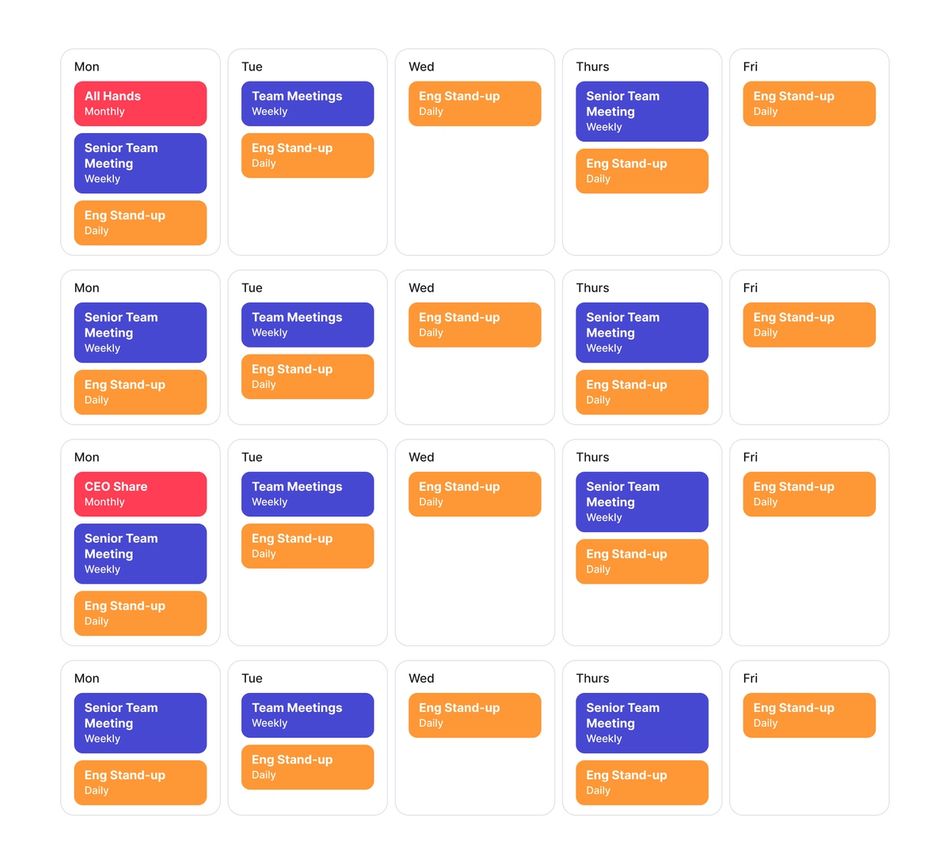Leading a team, especially a distributed or growing one, can be hard. Oftentimes the best advice and ideas come from other teams just like yours. That’s why we launched Lead Time: How Teams Work. This blog series profiles real teams, how they’re structured, and how they communicate through meetings and other touchpoints. Plus, each article features a top-notch leader who's got proven tips and real stories to learn from.
Meet Madhu Chamarty, Founder/CEO at Beyond HQ
Madhu leads the team at BeyondHQ — a startup of 15 people who work remotely across the U.S. and South America.
We sat down with Madhu to learn how his team strikes the right balance between meetings and asynchronous communication to keep everyone marching to the beat of the same drum.
How the team works
Team structure
The BeyondHQ team consists of 8 full-time team members and 7 contractors spread across engineering, customer success, product design, and sales. They’re fully remote, though sometimes teammates will get together in a coworking space if they’re in the same city.
Team meetings and communication cadence
Here’s a look at the typical meetings and async touchpoints that happen at BeyondHQ.

Daily:
- Eng standup: A 30-minute meeting where product team members share what they did yesterday and what they’re doing today, discuss blockers, and flag issues.
- Slack and Jira: The team uses Slack to connect and communicate with each other throughout the day. They use Jira to track projects and tasks.
Weekly:
- Senior team meeting: Twice each week, BeyondHQ leadership meets to discuss how the company’s tracking towards goals in finance, sales, and marketing. Attendees include the head of product, the CEO (Madhu), and the COO.
- Team meetings: Different functions meet each week to collaborate and discuss challenges or learnings in their area.
Monthly
- Company all-hands: The whole BeyondHQ team gathers to discuss business updates and celebrate each other’s work.
- CEO share: Every few weeks, Mandhu sends out a “from the desk of the CEO” document to share what’s top of mind and how he’s thinking about the direction of the company.
Madhu’s top tips for running a remote organization
1. Prioritize documentation above all else
The biggest learning for Madhu as CEO of a fully remote company has been just how vigilant you need to be when it comes to project-, team-, and company-level documentation.
“Even as a small team, I’ve heard people say ‘I had no idea we're doing that.’ We're just 15 people — but since we’re remote, it’s still a challenge.”
For this reason, Madhu has made documentation and team-wide visibility a top priority this past year.
“We're building a culture of documentation — documenting changes in process, documenting new initiatives — so people always have a reference point to read up on,” says Madhu. “I’m learning that the best way to run any company, whether you're remote or not, is to assume that everybody's remote. You have to go to painstaking levels of detail to make sure that context isn’t lost.”
One way Madhu has worked to improve documentation has been through regular CEO update emails, which include an evolving Google Doc that gives visibility into the direction of the company.
Another is through standardizing the ways different teams share updates, moving important conversations out of one-off Slack threads and into more lasting, referenceable artifacts instead.
“I think we’ve been using Slack more than we should for certain things. We’re trying to reorganize what information gets shared where to make things more cohesive and bring everyone along,” he explains.
Focusing on documentation has helped Madhu’s team move and adapt more quickly, since it’s easier for everyone to keep tabs of what’s happening and get up to speed fast. This is a huge advantage at a growing startup. It’s also helped them decrease the number of hours they spend in meetings each week, freeing up more time for everyone to get work done.
“I'm always thinking, how do you ensure that everybody's marching to the beat of the same drum?” he says.
2. Invest in more asynchronous communication
Madhu’s team keeps it pretty light on meetings — choosing to stay aligned via asynchronous communication in most cases instead.
“We don't do meetings unless absolutely necessary. And if they are, we try to keep it to 30 minutes,” he explains.
Async communication helps the team build alignment that either eliminates the need for a meeting, or makes the time together more effective.
“It forces you to be efficient and articulate with what you’re communicating,” Madhu adds.
This forcing function also helps the team reach a greater level of clarity together. When you have to put thoughts in writing beforehand, it naturally helps you tighten up what you’re trying to communicate. And when folks have time to read and process what’s happening, instead of reacting in real-time, they’re able to give more productive, thoughtful feedback too.
“I learned that at Amazon, it's a pretty big writing culture,” explains Madhu. “One of the things they do at the start of a meeting is distribute a pre-read to everyone in the room. And for the first 10 minutes, you read it silently. It's mandatory reading of four or five pages before you start the meeting.”
Async communication is a natural extension of Madhu’s goals around better company documentation too. Since most of their communication now happens in written form, there’s always an artifact to point people back to. It helps build alignment and gives the team something to review, react to, and reevaluate later on.
Learn more ways to incorporate async communication into your team’s daily practices







